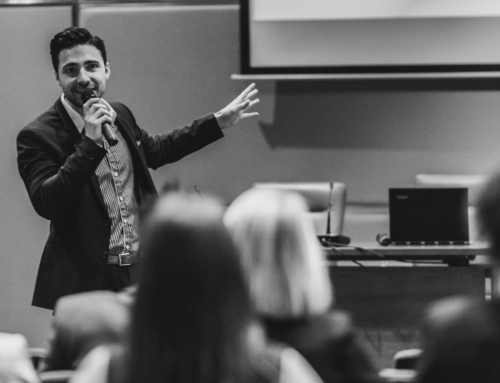The oldest chestnut in public speaking advice is to “tell ‘em what you’re going to say, say it, and then tell ‘em what you said.” The idea is that repetition will hammer things home to your audience and help them remember.
Unfortunately, that’s bad advice today for a number of reasons. First of all, the only thing that your audience will get when you go at them with a hammer is a headache. Audiences these days are extremely sensitive to having their time wasted, and they’re easily distracted. So when you start with that agenda slide (tell ‘em what you’re going to say) their attentions immediately wander, they pick up their phones, and you’ve lost ‘em.
Instead, launch right in with a framing story or an idea that will grab their attention and at the same time tell them why they’re there. That’s what audiences want to have answered right away – not what you’re going to say, but why they’re there.
After that, the art of public speaking is the art of deciding what NOT to say. The urge, when you combine expertise, adrenaline and an audience, is to tell that audience everything you know. Unfortunately, long after the audience's enthusiasm has waned, because they're overloaded with information, you'll still be going strong — because you love the subject!
So you need to decide what the one vital idea is that you want to get across. And one more thing: your emotional attitude toward that idea.
A great presentation is composed of two things: one interesting idea and the speaker's emotional attitude toward that idea. It's that simple. Don't lard up your speech with caveats, asides, extras, nuances, added thoughts, one more thing, or anything else. Stick to your well-honed subject and make your attitude clear and your audience will love you.
Even more important, they'll understand you. And remember what you say.








Thanks Enigmatic Coach Nick, I loved your article, Its hard to decide which article of your is the best, because all of them are “State of Art”. Can you let us know how can a speaker create an emotional attitude toward an idea or story.
Thanks,
Adil
Hi, Adil —
Thanks for your comment. Look under Category 5 — Rehearsal and Preparation — for a number of blogs on how to create an emotional attitude toward an idea or story. Also my eBook, “How to Give a Great Speech,” for more on the subject. And then, of course, my book “Trust Me” gives the fullest description of how to do this.
This is one piece of advice I heard a lot when I first joined Toastmasters years ago. As I moved on and started looking at other sources of learning, this is just one of many bits of advice I discovered that get thrown around by people who mean well, but don’t really know what it takes to do professional presentations in the ‘real world’. Having said that, unfortunately I also hear of it still being recommended by professional trainers as well.
Great blog Nick.
Thanks, David, for the thoughtful comment. I do hope Toastmasters is no longer telling people this old chestnut, which actually came out of WWII.
Thanks Coach Nick, I will follow your command like a good student, thank you once again for your advice & cool posts.
Thanks,
Adil
Wow just discovered you on Speaking Pro Central and love this advice. I always felt like I was wasting people’s time doing it that way so I’d skip it. Most times they’ve already seen the topic description/bullets anyway! There are other ways to build anticipation/set it up as you suggested. I’ll be exploring your site more now – thanks!
Karen
Hi, Karen —
Thanks for your comment, and enjoy exploring! Let me know what you find and find most helpful.